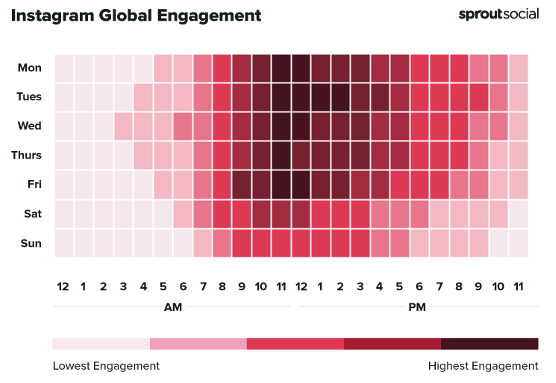
Not Marketing on Instagram? 10 Tips on How to Get Started
Almost 50% of investors say social media impacts who they hire as a financial advisor. Moreover, 20% are using it as their sole deciding factor. This data should represent something of a sea change for many financial advisors—from viewing social media as optional activity to seeing it as a necessity.
The question now becomes which social media platform(s) to use?
Instagram (which is owned by Facebook) has emerged as an opportunity for financial advisors looking for a social media platform where they can stand out. With over a billion users, Instagram ranks as the fourth most popular social network. Meanwhile, Facebook dominates with over 2.8 billion users. But audience size isn’t everything.
When ranked by user engagement rates for financial services, a different story emerges:

Source: https://www.rivaliq.com/blog/social-media-industry-benchmark-report/#title-financial-services
Financial Services posts enjoy a much healthier engagement rate on Instagram (0.85%) compared to the more anemic rate on Facebook (0.07%). Additionally, 63% of adult users check their account daily and the average user in the US spends about 7 hours per week on the platform. That’s a large, attentive audience to engage with.
Now that you see the opportunity, how do you get begin? Here are 10 tips for getting started marketing on Instagram.
- Set goals
Before setting up your account ask yourself, “Why am I using Instagram?” Are you trying to amplify brand awareness or connect with a new niche audience? You can have several distinct goals but it’s essential to know what they are before you begin marketing. A clear goal allows you to define your strategy and measure performance. - Know your audience
Once you know why you’re using the platform, you need to determine whom you’re talking to. Draw from your other marketing efforts to keep your strategy consistent. If you don't have this information, begin by building a buyer persona. Our Growth Guide can help you begin this process. This exercise will help you identify and understand your audience. Keep this profile in mind whenever you're crafting a post or other content. - Setup your account
You've identified why you’re using Instagram and who you’re talking to, now you’re ready to setup your account. Here’s a few key points to keep in mind:
-
- Pick a recognizable username
This will ensure that new and existing clients can find and follow you. - Choose an up-to-date headshot
Your photo should convey the right image for your brand. And it should be one used on your website and other social media accounts to be consistent. Don’t have one or need a new one? Here are some tips that can help. - Don’t ignore your bio
Be sure to say who you are and what you do. Also, use the link in your bio to highlight your website, blog, or other service offerings.
- Pick a recognizable username
- Switch to a professional account
Instagram business profiles give you access to key tools that will increase the effectiveness of your marketing efforts and improve searchability. With a business profile you gain the ability to:
-
- Add an industry for your business
- Add your office address
- Add a dedicated contact button to your profile
- View account analytics
- Run paid ads
- Schedule your posts
Unfortunately, there is no way to default to a business profile during the initial setup process. However, making the switch couldn’t be easier. Simply follow these steps.
- Plan your posts ahead of time
The last-minute scramble for content is the easiest trap to fall into but avoidable with some planning. Using a social media calendar allows you to organize and schedule posts ahead of time. HubSpot, an industry leader in inbound marketing software, offers a complimentary calendar template and guidance on how to use it. - Post at the right times
A great piece of content is only valuable if it’s seen and acted upon by your audience. Increase your chances by posting at times shown to result in greater engagement. Looking at the chart below, the best day to post is Tuesday between 11AM - 2PM. More broadly, weekdays at 11AM could also lead to better engagement. Source: https://sproutsocial.com/insights/instagram-stats/
Source: https://sproutsocial.com/insights/instagram-stats/ - Keep your branding consistent
The adage that a picture is worth a thousand words is particularly true on Instagram.
Fortunately, you don’t have to be a graphic designer to create beautiful imagery. There are a variety of online services that make image creation easy. Apps such as Canva provide a large selection of templates that allow you to add your logo, brand colors, and copy.
But the need for consistency goes beyond graphics and extends to photos. For photos, make sure the subject is clear and well lit. If you apply filters, be consistent in your selections across posts. This consistency will make your feed feel professional, cohesive, and thoughtful.
Nicole Perterkin, CFP®, CLU®, ChFC® of Peterkin Financial is a great example of what advisors should work toward on Instagram. To see more, follow @peterkinfinancial.
- Use hashtags strategically
Hashtags are a great way to increase the visibility and engagement of your posts (#obvious). In fact, a post with at least one Instagram hashtag averages 12.6% more engagement than posts without a hashtag. Here are a few tips on using them effectively:
- Pick hashtags relevant to your industry or subject matter.
- While there is no hard rule, most posts commonly use 1-3 hashtags per post. This can differ per industry, so I would recommend doing some testing to see what works best for you.
- Pick hashtags relevant to your industry or subject matter.
- Video should be part of your content strategy
Video posts on Instagram receive twice as much engagement compared to other posts. Using video, you can engage your followers and show your expertise as a financial planner.
For example, let's say you notice a reoccurring topic among your clients. Why not create a video post addressing that topic? You’re creating a valuable piece of content that positions you as subject matter expert. Moreover, you're giving potential clients a glimpse into what you'd be like to work with. - Don’t ignore Instagram Stories
What are Stories? They’re a separate feed of short-form video content that disappear after 24 hours. You do have the option to save a Story to your profile as a highlight or add interactive elements like polls.
You know what Stories are but why are they a big deal? Stories skip the line on users' feeds, making them the first content seen. Since they’re always first in the feed, they drive higher engagement and can get more eyes on your profile. Over 500+ million use the format daily and 1/3 of the most viewed stories come from brands. That’s a lot of opportunity to connect with prospects.
These 10 tips will put you on solid footing as you begin your journey on Instagram. But remember social media is ever evolving and what works today may not work tomorrow. Continue to educate yourself as the space continues to evolve. Best of luck!
Symmetry Partners, LLC, provides this communication on this site as a matter of general information. Information contained herein, including data or statistics quoted, are from sources believed to be reliable but cannot be guaranteed or warranted. Nothing on this site represents a recommendation of any particular security, strategy, or investment product. The opinions of the author are subject to change without notice. Due to various factors, including changing market conditions and/or applicable laws, the content may not be reflective of current opinions or positions. All content on this site is for educational purposes and should not be considered investment advice or an offer of any security for sale. Please be advised that Symmetry Partners does not provide tax or legal advice and nothing either stated or implied here on this site should be inferred as providing such advice. Symmetry Partners does not approve or endorse any third-party communications on this site and will not be liable for any such posts.
